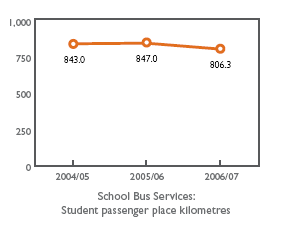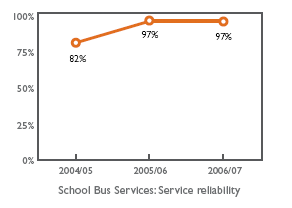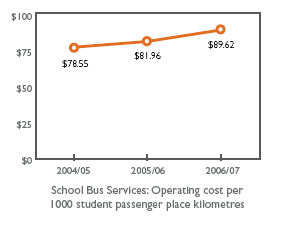The school bus network comprises 688 school buses servicing mainstream schools, 117 school buses servicing special education schools, centres and units and seven Regular Public Transport service arrangements.
In 2006/07, these services were used by 26,200 students per school day around the State, using predominantly contracted orange school buses. Alternatively, where eligible students could not be accommodated on a school bus, their parents/carers were paid a conveyance allowance to help meet some of the costs incurred by them in getting their children to their nearest appropriate school.
The total cost of managing the 812 school bus contracts/services and providing the conveyance allowance totalled $70.826 million in 2006/07.
Transport assistance was also provided to students attending special education schools principally in large regional towns and in metropolitan Perth.
All orange school buses are operated by private contractors. Three contract/service models were used in 2006/07 to provide student transport support:
Composite Rate Model (CRM) Contracts (20-30 years in duration): 694 contracts
Fixed term Contracts (Tendered over 1-15 years since 1995): 111 contracts
Regular Passenger Transport (Licence arrangement with fare subsidy): 7 contracts
The Composite Rate Model is an average cost model which was implemented in January 2004 and provides for contractor payments, with the cost elements of the payment model being reviewed over a three-year cycle by an independent review panel.
OBJECTIVES AND OUTCOMES
| OBJECTIVE | OUTCOME |
|---|---|
Provide transport assistance for eligible students to assist them to attend their nearest government or non-government school offering the appropriate year of study. | 812 “orange” school bus contracts were managed and conveyance allowances to entitled students totalling $70.826 million were paid. |
Ensure the transport assistance provided to students is appropriate, safe, cost effective and fair in its application. | Continued to manage the introduction of seat belts on government-funded orange school buses. Conducted two safety inspections on every school bus in the fleet during the year. |
Ensure that all service contracts are managed effectively and efficiently in accordance with agreements made between the Minister, the PTA and individual contractors and/or their representatives. | Special education bus routes in metropolitan Perth and regional towns were reviewed. School bus routes that serve the fringes of metropolitan Perth were reviewed. |
REVIEW OF PERFORMANCE
1. Total Services Provided
In 2006/07, student passenger place kilometres fell by 4.8% due to the reduction in the number of school days in the year from 187 in 2005/06 to 181 in 2006/07.

2. Service Reliability
The service reliability measure covers rural mainstream services and Education Support school buses operating in the Perth metropolitan area. The reliability measure is arrival less than 10 minutes before school starts and departure less than 10 minutes after school finishes.
In 2006/07, service reliability was maintained at 97%, which was unchanged from the previous year.

3. Cost of the Service
The operating cost per 1000 student passenger place kilometres increased by 9.34% in 2006/07. This was due to higher wage and fuel costs.

THE YEAR’S DEVELOPMENTS
School bus routes were reviewed to maximise service delivery and efficiencies in metropolitan Perth.
The 50 cent student fare was introduced on orange school bus services operating in the Upper Swan/Gnangara and Mandurah areas within the Perth Public Transport Area. This was done for equity reasons to ensure that all school students paid the fare to school if they resided in a designated public transport area. In a number of areas, the introduction of the 50 cent fare was deferred until Term 3, 2007 so that duplication of services with Transperth could be removed.
Seven new Education Support bus services were introduced in the Rockingham area to meet population growth.
School bus routes in Serpentine, Waroona and Bullsbrook were reviewed to maximise service delivery and efficiencies.
The Busselton/Dunsborough Town Public Transport Area and the collection of fares on school buses within this area were implemented.
Progress continued on the project to fit seatbelts on all Government-funded school buses by 2015. This included a tender being awarded in January 2007 to Omnibus Services to retrofit 42 class B and class C buses with belted seats. Through normal bus replacement, 125 new buses with seatbelts already fitted entered the fleet and 14 further buses were retrofitted during the year.
A total of 139 buses (over 17% of the school bus fleet) had seat belts fitted by 30 June 2007 – 42 class A buses, 16 class B buses, 35 class C buses, and 46 class D buses.
In March 2007, the PTA pursued further best practice by moving to have drivers’ seats also fitted with ADR68 lap-sash seatbelts.
The new Tendered Rate Model (TRM) contract was developed for new school bus services as part of PTA’s strategy to replace over 100 fixed-term orange school bus contracts that were either expiring or had recently expired. At 30 June 2007, of the 50 TRM contracts that had been tendered during the year, 28 were awarded and the others were at various stages of evaluation and award.
PLANNED MAJOR INITIATIVES FOR 2007/08
- Continue installation of seatbelts on all
Government-funded school buses by December
2015 in accordance with Government policy.
- Complete retrofitting the remaining 28 buses under Omnibus Services contract.
- Implement a student seatbelt compliance communication strategy through the Department of Education and Training.
- Commence replacing the aging school bus fleet in the RPI “grouped” services that feed into Bunbury from surrounding rural areas, with new buses with belted seats.
- Continue the review and, where required,
efficiency rationalisation of school bus routes.
- Introduce the 50 cent student fare on services in the Kalamunda, Forrestdale, Armadale and Baldivis areas to continue the equity process of applying fares to all children residing in the Perth Public Transport Area and using buses.
- Develop a new service contract for Department of Education and Training funded transport assistance for English Second Language students (deferred from 2006/07).
- Relocate/review bus education support services over the next two financial years to the new Kim Beazley Learning Centre sites in Atwell (2008) and Success (2009).
- Place the Bunbury RPT school bus service under long-term contract for future efficiency gains when the service is later tendered.
- Continue re-tendering expiring contracts under the TRM contract (approximately 50 contracts).
- Continue liaison with the Department of
Education and Training to review the student
transport assistance policy with regard to:
- integration of students with special needs into mainstream schools,
- compulsory school attendance to Year 12 (2008),
- integration of vocational studies into school curriculum through increased usage of TAFE facilities,
- transport provision when school facilities are opened or closed.



